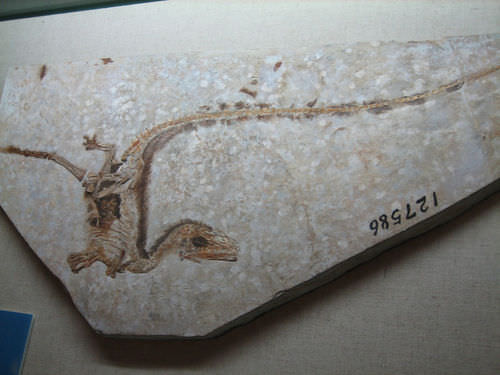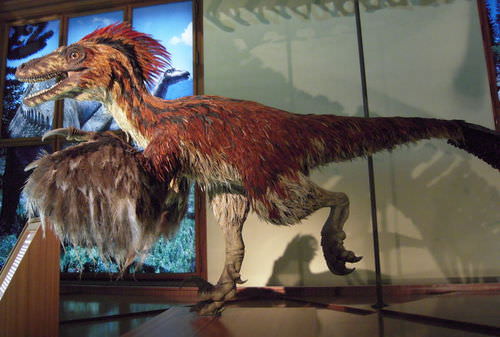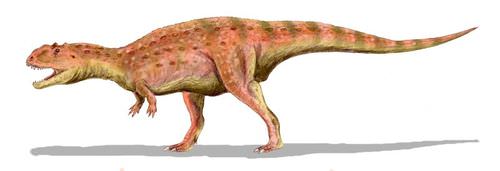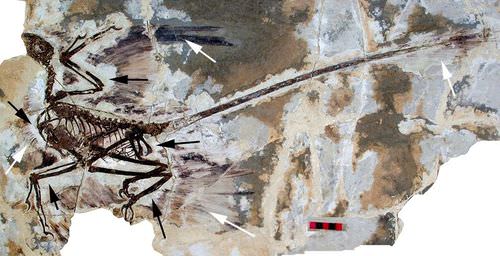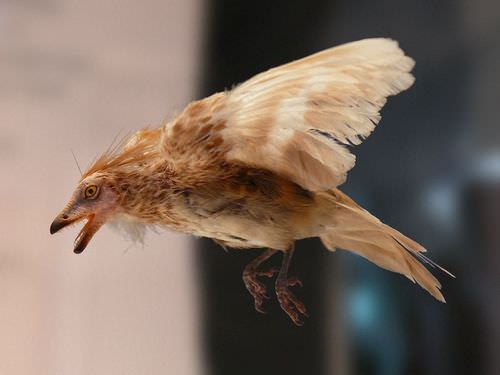16.35 鸟类进化 -- -- 先进
章节大纲
-
Did really evolve from dinosaurs ?
::真的是从恐龙进化而来的吗?One is an ostrich, the other is a mononykus dinosaur. The structural relationship is obvious. Mononykus moved about on two legs, was very nimble, and could run at high speeds—something that would have been useful in the open plains where they lived. It had a small skull, and its teeth were small and pointed, suggesting that it ate and small such as lizards and mammals .
::一种是小蚂蚁,另一种是单龙恐龙。 结构关系显而易见。 蒙诺尼库斯两条腿移动,非常灵活,并且可以高速运行 — — 这在他们居住的开阔平原是有用的。 它有一个小头骨,牙齿很小而且尖锐,表明它吃过蜥蜴和哺乳动物等小东西。Evolution of Birds
::鸟类的演变The origin of birds has been a topic of debate within evolutionary biology for many years, but, more recently, a scientific consensus has emerged, holding that birds are a group of theropod dinosaurs that evolved during the (from about 251.0 million years ago to 65.5 million years ago). The evolution of birds is thought to have begun in the Jurassic Period (between about 199.6 and 145.4 million years ago), with the earliest birds evolved from theropod dinosaurs.
::鸟类起源多年来一直是进化生物学中争论的主题,但最近出现了科学共识,认为鸟类是在这一时期(从大约2.51亿年前到6,550万年前)演化的一组原生恐龙。 鸟类的演化被认为始于侏罗纪时期(大约199.6万年前到14.54亿年前 ) , 最早的鸟类是从原生恐龙演变而来的。Theropods ('beast feet') are a group of bipedal dinosaurs. Among the features linking theropods to birds are the three-toed foot, a furcula (wishbone), air-filled , and (in some cases) feathers and egg brooding . Today, theropods are represented by the approximately 10,000 living of birds, which evolved in the Late Jurassic period from small coelurosaurian dinosaurs such as the Sinosauropteryx shown in Figure . Sinosauropteryx is the first and most primitive genus of dinosaur found with the fossilized impressions of feathers. Well-preserved of Sinosauropteryx show that they were covered with a furry down of very simple feathers. However, some scientists believe that the “feathers” are just hairs.
::类动物(“野兽脚 ” ) 是一群双头恐龙。 将类动物与鸟类联系在一起的特征包括三趾脚、一只毛骨(wifbone),一个填充空气的羽毛,以及(在某些情况下)羽毛和鸡蛋。 今天,类动物有大约一万只鸟类的活体,这些鸟是在侏罗纪后期从小锥体沙乌里亚恐龙(如图中所示的Sinosausopropteryx)中演变而来的。 类动物是第一和最原始的恐龙基因,其羽毛印有化的印象。 中观的草质表明,它们被一个非常简单的羽毛毛毛所覆盖。 然而,一些科学家认为,“羽毛”只是毛。A fossil of Sinosaupteryx, a theropod dinosaur. Scientists are able to create life-like models of ancient animals based on their fossilized remains. The largest known sinosaupteryx are 1-1.2 m (3 ft) in length, most of which was taken up by its long tail.
::科学家能够以其化石化石的残骸为基础创造出类似生命的古老动物模型。 已知最大的一至一万二米长(3英尺)的骨质动物,其中多数被长尾动物吸收。A close relationship between birds and dinosaurs was first proposed in the nineteenth century after the discovery of the primitive bird Archaeopteryx in Germany. Since the 1960s, this relationship has been confirmed by studies and the other evolutionary analyses.
::鸟类和恐龙之间的密切关系是19世纪在德国发现原始鸟类Archaepteryx后首次提出来的。 自1960年代以来,这种关系得到了研究和其他进化分析的确认。Archaeopteryx lithographica, shown in Figure , is the earliest known member of the class Aves, to which birds belong. Archaeopteryx lived during the Late Jurassic period, around 155–150 million years ago. Despite its small size, broad wings , and ability to fly, Archaeopteryx has more in common with small theropod dinosaurs than it does with modern birds. In particular, it shares the following features with the deinonychosaurs (including velociraptors and microraptors): jaws with sharp teeth, three fingers with claws, a long bony tail, second toes with a curved claw, and feathers (which also suggests it may have been warm-blooded).
::图中显示的Archapteryx lithphia是鸟类所属的Aves类中最早已知成员。 Archapteryx生活在侏罗纪末期,大约155—1.5亿年前。 尽管其体积小,翅膀宽,飞行能力小,但Archapteryx与小型的原生恐龙的共性比现代鸟类大。 特别是,它与Deinonyhosaurs(包括迅猛猛龙和微强药)分享了以下特征:尖牙下巴、有爪子的三根手指、长尾巴、有弯爪的第二只脚趾和羽毛(这也表明它可能是热血的 ) 。A model of Archaeopteryx lithographica. Scientists do not believe that Archaeopteryx is the direct ancestor of modern birds. Archaeopteryx had many reptilian characteristics, such as teeth and a long bony tail, but it had feathers, which would indicate it was endothermic (warm blooded) and not exothermic like modern reptiles.
::科学家们并不认为考古学家是现代鸟类的直接祖先。 考古学家有许多爬行动物特征,如牙齿和长长的尾巴,但它有羽毛,这说明它是末端热(热血 ) , 而不是现代爬行动物外热。In the 1960s, American palaeontologist John Ostrom examined Deinonychus, a carnivorous theropod dinosaur that lived during the early Creataceous period (121 to 98.9 million years ago). He discovered that Dienonychus had many bird-like features and also had features similar to Archaeopteryx. The description in 1969 by Ostrom of Deinonychus has been described as the single most important discovery of dinosaur paleontology in the mid 20th century. The discovery of this clearly active, agile predator did much to change the scientific (and popular) idea of dinosaurs as "cold-blooded," sluggish animals. Ostrom noted similarities between the forefeet of Deinonychus and those of birds. This observation led him to revive the hypothesis that birds are descended from dinosaurs. Thirty years later, this idea is almost universally accepted. At least phylogenetically, birds are dinosaurs.
::1960年代,美国古生物学家约翰·奥斯特伦检查了Deinonichus, 这是一种在早期创世时期(121-9890万年前)生存的食肉动物类恐龙。他发现Dienonychus有许多类似鸟类的特征,也具有与Archaeopteryx相似的特征。1969年Ostrom对Deinonichus的描述被描述为20世纪中叶恐龙古生物学中最重要的单一发现。发现这种明显活跃的、敏捷的捕食动物对改变恐龙的科学(和流行)概念,即恐龙是“冷血的 ” 、 缓慢的动物。Ostrom注意到Deinonychus的食人与鸟类的相似之处。这一观察使他恢复了鸟类从恐龙中下来的假设。30年后,这种想法几乎被普遍接受。至少具有植物特征的鸟类是恐龙。Only a few scientists still debate the dinosaurian origin of birds. Those that do debate this origin suggest descent from other types of lizard like creatures called Longisquama. This theory is contested by most other paleontologists and experts in feather and evolution.
::只有少数科学家仍在讨论鸟类的恐龙起源。 确实有这种起源的科学家认为,这种起源意味着从其他种类的蜥蜴(比如叫Longisquama的生物)中下沉。 这一理论受到其他大多数羽毛和进化方面的古生物学家和专家的质疑。The consensus in contemporary paleontology is that birds are the closest relatives of dinosaurs called dromaeosaurids. Dromaeosauridae is a family of bird-like theropod dinosaurs. The name Dromaeosauridae means 'running lizards' (from the Greek words dromeus, meaning 'runner,' and sauros, meaning 'lizard'). Birds share hundreds of unique skeletal features with dromaeosaurids. The dromaeosaurids were carnivorous dinosaurs that had a large sickle-shaped talon on their second toes that they used to stab prey . Dromaeosauridae includes some of the most fearsome killers of the Cretaceous Period such as Deinonychus, Velociraptor, and Microraptor. Dromaeosaurs are commonly called raptors (after Velociraptor ), which should not be confused with the use of the term to identify modern birds of prey.
::当代古生物学的共识是,鸟类是恐龙的最亲近的近亲,它们称为droomaosaurids。Dromaeosauridae是一群鸟类的象象象象热带恐龙的恐龙。Dromaeosauridae的名字是指“流蜥蜴”(希腊语中的“runomeus,意思是“runner,”和“sauros”,意思是“lizard”)。鸟类与droomaosaurids共有数百个独特的骨骼特征。Dromaeosaurids是食肉恐龙,它们第二只脚趾上有一个大镰状的,它们用来刺杀猎物。Dromaeosauridae包括一些在白鲸时期最可怕的杀手,如Deinonychus、Velsocraptor和miraptor。Dromaeosaurs通常被称为“猛龙”,这些恐龙不应与使用这一术语来识别现代猎物鸟类混淆。Deinonychus, shown in Figure , was almost certainly feathered, since its close relative Velociraptor was shown in 2007 to have been feathered. Scientists found structures called quill knobs on the forearm of a Velociraptor. Quill knobs show where feathers anchor in the skin of modern birds. This recent discovery added weight to already strong theories that all dromaeosaurs were feathered. The ongoing discovery of feathered dinosaur fossils has shed new light on the evolution of birds.
::图中显示的Deinonychus几乎肯定是羽毛,因为其近距离相近的迅猛龙在2007年被显示为羽毛。科学家在巨猛龙的前臂上发现了被称为quill knobs的结构。Quill knobs展示了现代鸟类皮肤中的羽毛锚。最近这一发现增加了已经十分强烈的理论的重量,即所有色狼都是羽毛。正在发现的羽毛恐龙化石为鸟类的进化提供了新的线索。Dienonychus, whose name means “terrible claw,” had an unusually large sickle-shaped talon on the second toe of each foot, which was probably held up off the ground while the dinosaur walked on the third and fourth toes. Deinonychus could reach 3.4meters (11.1ft) in length, much bigger than Velociraptor.
::迪安诺尼丘斯(Dienonychus)的名字是“可怕的爪子 ” , 其一脚的第二个脚趾上有一个异常大的大镰刀形的爪子,它很可能在恐龙走在第三和第四个脚趾时被挡在地上。 迪尼诺尼琴可以长到3.4米(11.1英尺 ) , 比迅猛龙大得多。Although harder to identify in the , similarities in the digestive and cardiovascular systems, as well as behavioral similarities and the shared presence of feathers, also link birds with dinosaurs.
::虽然在消化和心血管系统中的相似性, 以及行为上的相似性和羽毛的共同存在,Majungasaurus crenatissimus had a respiratory system that was very similar to birds. This dinosaur lived in Madagascar from 70 to 65 million years ago, at the end of the Cretaceous Period.
::Majungasaurus crenatismus的呼吸系统与鸟类非常相似。 在白鲸期结束时,这只恐龙从7000万到6,500万年前生活在马达加斯加。Recent studies have indicated the presence of a very bird-like in certain predatory dinosaurs such as Majungasaurus crenatissimus ( Figure ). These findings give more evidence of an evolutionary link between dinosaurs and birds. The presence of a pulmonary air sac system with flow-through ventilation similar to modern birds suggests that this group of dinosaurs could have had a fast metabolism , which means they were probably endothermic. The recent discovery of fossilized soft tissue within the bones of a Tyrannosaurus rex specimen opens the possibility of comparing dinosaur soft tissues to the soft tissues of modern birds. The researchers discovered minute amounts of the collagen within the leg bones of the T. rex.
::最近的研究显示,在某些捕食性恐龙(如Majungasaurus crenatismus (Figure )) 中存在一种非常像鸟类的鸟类。这些研究结果更证明了恐龙和鸟类之间的进化联系。 有一种与现代鸟类相似的流经通风的肺部空气囊系统的存在表明,这组恐龙可能具有一种快速的新陈代谢作用,这意味着它们可能具有通俗性。 最近在Tyrannosaurus rex标本骨骼中发现化化的软组织,这为将恐龙软组织与现代鸟类软组织进行比较提供了可能性。 研究人员在T. rex的腿骨中发现了少量的共生物质。Origin and Evolution of Flight
::飞行的起源和演变The origin of bird flight is a separate, but related, question to the origin of birds, and there are several proposed answers. Most birds can fly, which distinguishes them from almost all other vertebrates . Flight is used by modern birds as a means of , feeding, and avoiding and escaping predators.
::鸟类飞行的起源是一个单独但相关的问题,与鸟类的起源有关,并提出了好几项答案。 多数鸟类可以飞翔,这与几乎所有其他脊椎动物有区别。 现代鸟类将飞翔用作捕食、回避和躲避捕食动物的手段。Comparing the structures of the wings of likely ancestors of birds would give the best evidence for how wings evolved. But finding out why wings and flight evolved is also an active area of research among scientists. Different hypotheses addressing why flight evolved have been put forward:
::比较鸟类可能祖先的翅膀结构可以提供翅膀如何演进的最佳证据。 但找出翅膀和飞行为何演进也是科学家研究的一个积极领域。 提出了不同的假设来说明飞行为何演进:-
Wings evolved from arms used to capture small prey.
::翅膀从用来捕捉小猎物的武器中演变而来。 -
Wings evolved because bird ancestors leapt into the air to capture prey or to avoid predators, and wings helped the animal leap higher.
::翅膀的进化是因为鸟类祖先跳进空中 以捕食猎物或躲避掠食者 翅膀帮助动物跳得更高 -
Wings evolved from ancestors who lived in trees and glided from branch to branch. Flapping their gliding structures (arms) helped them glide farther.
::双翼从生活在树木中的祖先演变而来,他们从树枝滑行到树枝,他们用滑翔结构(武器)滑行,帮助他们滑行更远。
Scientists can investigate these hypotheses by studying other flying vertebrates: pterosaurs and bats. Pterosaurs (now extinct) were the first vertebrates to evolve true flight.
::科学家可以通过研究其他飞行的脊椎动物:巨龙和蝙蝠来调查这些假设。 白龙(现已绝种的)是第一个进化真正飞行的脊椎动物。Origin of Feathers
::羽毛的起源Coelurosauria is a diverse group of theropod dinosaurs that includes tyrannosaurs, ornithomimosaurs, and maniraptors. Recall that the first and most primitive genus of dinosaur found with fossilized impressions of feathers, Sinosauropteryx, was a coelurosaur. Maniraptora includes birds, the only coelurosaurs alive today. All feathered dinosaurs discovered so far have been coelurosaurs. In fact, some scientists believe that most members of Coelurosauria had some kind of feathers. Some coelurosaurs, such as Tyrannosaurus, may have only had insulating, downy feathers as hatchlings .
::科伊罗萨乌里亚是一组多种多样的热带恐龙,包括强脊椎动物、鸟类和甲状腺动物。回顾发现第一种、也是最原始的恐龙基因,其羽毛有化化的印象,即Sinosauropteryx,是一只大肠杆菌。曼尼拉波拉包括鸟类,这是今天唯一活下来的食腐动物。迄今发现的所有羽毛恐龙都是龙。事实上,一些科学家认为,大多数科伊罗索里亚成员都有某种羽毛。有些象暴龙这样的共生龙可能只是作为孵化物的绝缘、下垂的羽毛。The recently discovered dromaeosaur called Microraptor has features that may have enabled it to glide or fly. At 55 to 77 cm (1.8 to 2.5 ft) long from its nose to the tip of its tail, Microraptor was among the smallest known dinosaurs. It had a keeled sternum and bird-like ribs. Microraptor had two sets of wings, on both its fore and hind legs, which can be seen in Figure . The long feathers on the legs of Microraptor were true flight feathers like those seen in modern birds. As in bird wings, Microraptor had both primary (anchored to the hand) and secondary (anchored to the arm) flight feathers. Scientist believe that Microraptor lived in the trees and may have used its four wings to glide from tree to tree.
::最近发现的色龙称为微虫,其特征可能使其滑翔或飞翔。在55到77厘米(1.8至2.5英尺)的长处,从鼻子到尾部的顶部,微虫是已知最小的恐龙之一。它有骨髓结骨和象鸟的肋骨。微虫在其前额和后腿上都有两组翅膀,见图。微虫腿的长羽毛是像现代鸟类那样真正的飞行羽毛。在鸟类翅膀中,微虫既有主羽毛(被割到手上),也有次要羽毛(被割到手臂上)。科学家相信微虫在树上住着两根翅膀,并可能用四根翅膀从树到树上滑翔。A fossil of Microraptor. Microraptor had a keeled sternum and bird-like ribs. It also had a pair of wings on both its fore and hind legs, the feathers of which are marked with white arrows.
::微虫化石,微虫有骨髓和象鸟一样的肋骨,它的前额和后腿都有翅膀,羽毛用白箭标出。Scientists are fairly certain that feather-bearing theropods existed by the mid-Jurassic Era (about 175.6 to 161.2 million years ago). It is likely that flight was "tried out" in several lineages of creatures, and by the mid-Cretaceous Period (about 120 million years ago), some creatures, such as the crow-sized Confuciusornis, had some peculiar bird-like features. For example, Confuciusornis's long tail was unfit for steering, and its wing shape seems rather specialized, although the arm skeleton was still quite dinosaur-like. However, Confuciusornis had a pygostyle similar to those of modern birds.
::科学家们相当肯定的是,在中极拉西克时代(约175.6万至16.12亿年前),有羽毛的类栖动物存在(约175.6万至16.12亿年前 ) 。 飞行很可能是在几条生物群中“尝试”的。 到了中大西洋时期(约1.2亿年前),有些生物,如乌鸦大小的孔雀,具有一些与鸟类相似的奇特特征。 比如,孔雀星的长尾巴不适合方向,其翅膀形状似乎相当专业化,尽管臂骨仍然很像恐龙。 然而,孔雀具有与现代鸟类相似的体型。A model of the Cretaceous bird Iberomesornis, an enantiornith.
::白鲸鸟的模型 伊比利亚米索尔尼斯, 一种对等的鸟类。Enantiornithes is an extinct group of primitive birds that were common in the Mesozoic Era. Almost all enantiornithes had teeth and clawed hands, like other primitive birds. Enantiornithines are thought to have left no living descendants.
::共生鸟类是一种灭绝的原始鸟类群体,在中索索伊克时代很常见。 几乎所有的共生鸟类都有牙齿和爪子手,与其他原始鸟类一样。 共生鸟类被认为没有留下任何活着的后代。The Iberomesornis shown in Figure was an enantiornithes. It lived between 137-121 million years ago in forested areas of what is now Spain. Iberomesornis romerali was more physically advanced than Archaeopteryx. Most other birds from this time (around 135 million years ago) have reptilian characteristics such as a long tail. The vertebral column of Iberomesornis ends in a pygostyle, just like in modern birds. Its wings still had claws, but the thumb claw was reduced, and its spinal column was not as rigid as those of modern birds.
::图中显示的伊比利亚-米索尔尼斯是一种对等的动物,它生活在现在西班牙的森林地区,在137至12亿年前的13.7亿到21亿之间。伊比利亚-米索尔尼斯的罗马人比大主教更具有体质先进。从那时起,大多数其他鸟类(大约1.35亿年前)具有爬行动物的特性,比如长尾尾巴。伊比利亚-米索尔尼斯的脊椎柱像现代鸟类一样,以皮歌风格结束。它的翅膀仍然有爪子,但拇指爪缩小了,其脊柱不像现代鸟类那样僵硬。Iberomesornis was small, having a wingspan of 10-15 centimeters and weighing about 50 g (2 oz). Overall, it was no bigger than a large modern sparrow, but it was well able to fly. It also probably hunted insects and small animals, plucking them out of the air or from the ground.
::伊比利亚米索尔尼斯是小国,其翼宽10-15厘米,重量约50克(2oz)。 总的来说,它并不比一个大型的现代麻雀大,但它能够飞翔。 它很可能还猎杀昆虫和小动物,把他们从空中或地面挖出来。Summary
::摘要-
The origin of birds has been a topic of debate within evolutionary biology for many years, but, more recently, a scientific consensus has emerged, holding that birds are a group of theropod dinosaurs that evolved during the Mesozoic Era.
::鸟类的起源多年来一直是进化生物学中争论的主题,但最近出现了科学共识,认为鸟类是中索佐伊克时代进化的一组热带恐龙。 -
Among the features linking theropods to birds are the three-toed foot, a furcula (wishbone), air-filled bones, and (in some cases) feathers and egg brooding.
::将类足类动物与鸟类联系在一起的特征包括三趾脚、(活骨)、填充空气的骨头以及(在某些情况下)羽毛和鸡蛋繁殖。 -
Sinosauropteryx is the first and most primitive genus of dinosaur found with fossilized impressions of feathers.
::西诺索罗梅特里克斯是第一个最原始的恐龙基因, 其羽毛有化石化的印象。 -
Archaeopteryx lithographica
is the earliest known member of the class Aves, to which birds belong.
::考古地理图是鸟类所属的Aves类中最早已知的成员。 -
The consensus in contemporary paleontology is that birds are the closest relatives of dinosaurs called dromaeosaurids. Dromaeosauridae is a family of bird-like theropod dinosaurs.
::当代古生物学的共识是鸟类是恐龙的最亲近的近亲 恐龙叫恐龙恐龙 恐龙叫恐龙 -
All feathered dinosaurs discovered so far have been coelurosaurs.
::迄今发现的所有羽毛恐龙 都是龙
Review
::回顾-
Which dinosaurs have been discovered to have feathers?
::哪些恐龙被发现有羽毛? -
When did the earliest birds evolve?
::最早的鸟类什么时候进化的? -
What similarities do birds share with theropods?
::鸟类和象类动物有什么相似之处? -
What species is the oldest known member of the class Aves? What features does it share with dinosaurs?
::Aves类中最古老的已知物种是什么?它和恐龙有什么共同特征? -
What evidence suggests that dinosaurs were endothermic like birds?
::什么证据表明恐龙像鸟儿一样有热性?
-
Wings evolved from arms used to capture small prey.

